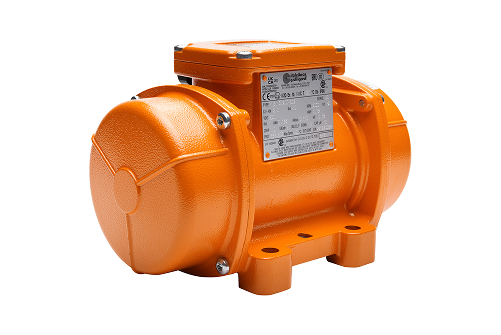An electric vibrating motor (also known as a shaker motor) is a device used to generate vibration in industrial applications. These motors are designed to create mechanical vibrations by converting electrical energy into rotational or linear motion, which is then transferred into the equipment it is attached to. The vibrating motion is used for a wide range of applications, such as material handling, sorting, and compaction.
Electric vibrating motors are widely used in industries such as mining, food processing, pharmaceuticals, construction, and many others where vibration is needed for processes like sieving, vibrating conveyors, hoppers, feeders, and compactors.
How Do Electric Vibrating Motors Work?
The basic working principle of an electric vibrating motor involves converting electrical energy into mechanical vibration. This is achieved by mounting an off-center weight or eccentric mass to the motor’s shaft. When the motor’s shaft rotates, the eccentric mass creates an unbalanced force that results in a vibration.
The vibration is a result of the rotational motion of the motor's shaft combined with the eccentric mass, which produces a vibrating force. The vibration frequency and amplitude can be adjusted by changing the motor's speed or the weight distribution, allowing for precise control over the intensity of the vibration.
Key Components of an Electric Vibrating Motor:
-
Electric Motor: The motor provides the rotational motion needed to generate the vibration. The motor is typically an asynchronous (induction) motor or sometimes a DC motor.
-
Eccentric Mass: This is the part of the motor that is mounted off-center on the motor shaft. The eccentric mass causes the motor to vibrate as it spins, generating mechanical vibration.
-
Bearings and Mounting: The bearings support the rotating shaft and ensure smooth operation. The motor is typically mounted on a vibration-resistant frame or base to prevent it from vibrating excessively and causing instability.
-
Adjustable Mechanism: Many vibrating motors feature an adjustable mechanism to vary the intensity of vibration. This can include adjusting the speed of the motor or modifying the eccentric mass.
Types of Electric Vibrating Motors:
There are several types of electric vibrating motors based on the application and the specific requirements of the vibration needed:
-
Unbalance Vibrating Motors:
-
These motors have an eccentric mass on the rotor shaft. The rotating motion of the motor creates an unbalanced centrifugal force that generates vibration. These are most commonly used for applications like vibratory feeders, hoppers, or screens.
-
-
Linear Vibrating Motors:
-
Unlike the traditional rotating vibrating motors, linear vibrating motors produce linear oscillations. These motors typically use an electromagnetic force to generate linear motion, which can be used in applications like shaker tables, conveyors, or testing machines.
-
-
High-Frequency Vibrating Motors:
-
These motors are designed for applications that require high-frequency vibrations, often used in sieving or screening systems where high-speed vibrations are needed to separate materials efficiently.
-
-
Vibration Motors with Adjustable Speed:
-
Some vibrating motors allow the user to control the speed of the vibration to suit specific requirements. This is typically achieved using a variable frequency drive (VFD) or adjustable weights on the eccentric mass.
-
Applications of Electric Vibrating Motors:
Electric vibrating motors are used in a variety of industries and for multiple applications. Here are a few common ones:
-
Vibrating Feeders and Conveyors:
-
In material handling, vibrating motors are used to create consistent vibration, ensuring that materials are transported smoothly and efficiently along a conveyor belt or feeder.
-
-
Sieving and Screening:
-
Vibrating motors are commonly used in the mining, construction, and food industries for sieving and screening materials like sand, gravel, and powders. The vibration ensures that materials are sorted by size and any unwanted particles are removed.
-
-
Shakers and Test Equipment:
-
Vibrating motors are used in shaker tables for testing materials or products, especially in industries like construction, pharmaceuticals, or automotive testing. These tests can simulate various environmental conditions to see how products perform under vibration.
-
-
Compaction:
-
In industries like construction or waste management, electric vibrating motors are used for compacting materials such as concrete, soil, or waste. The vibration helps settle the material and remove air pockets, improving density and consistency.
-
-
Vibrating Hoppers and Silos:
-
Vibrating motors are often used in hoppers or silos to help prevent material blockages. The vibration keeps materials flowing and prevents them from clumping together.
-
-
Vibratory Screens:
-
In mining, food processing, and recycling, vibrating motors are often used in vibratory screens to separate particles by size or weight, making it easier to sort materials efficiently.
-
-
Packaging and Sorting:
-
Vibrating motors are also used in the packaging and sorting of items in industries like food production and pharmaceuticals. Vibration ensures that products are correctly positioned, aligned, or compacted before they are packaged.
-
Advantages of Electric Vibrating Motors:
-
Efficient and Cost-Effective: Electric vibrating motors are energy-efficient and easy to maintain, making them a cost-effective solution for various applications.
-
Reliable Performance: These motors provide reliable and consistent vibration, ensuring that industrial processes run smoothly without frequent interruptions or downtime.

